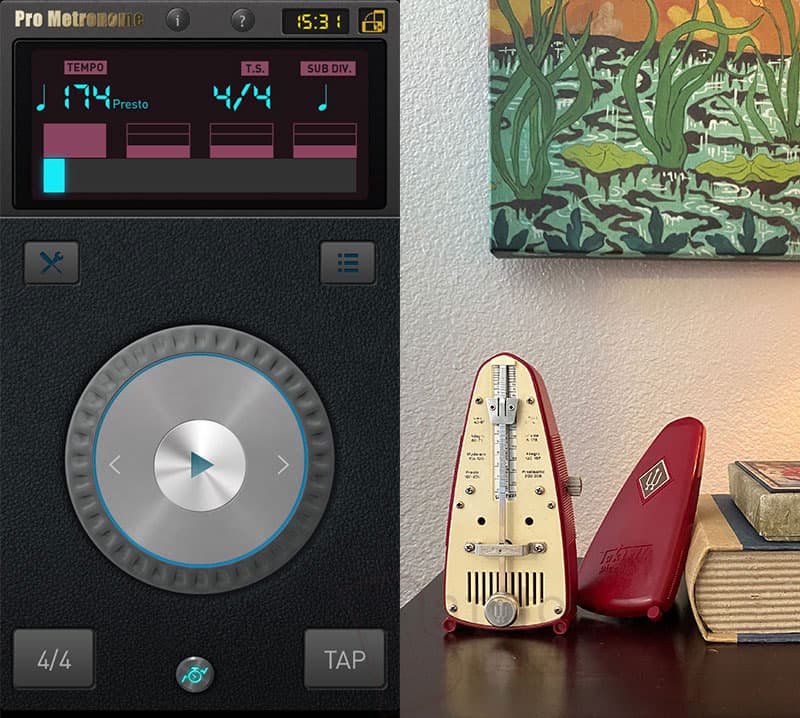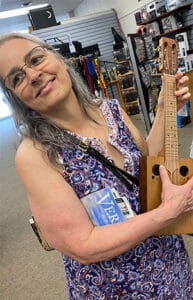Want to learn baritone ukulele faster so you can start jamming right away? Here are my top eight tips and tricks that helped me accelerate my progress and helped my brain and muscle memory learn to work together faster.
Tip #1: Five minutes of daily rhythm
I vividly remember the first time I jammed with professional musicians. What a rush. It was like soaring above the clouds. Everything changed after that.
But to get to that point, I had to learn to play in time with a beat.I resisted metronome work. It seemed a bit disorienting at first, because my internal rhythm was speeding up and slowing down throughout a song.
But after a short time I began to LOVE the metronome because… it works! A metronome is like Harry Potter’s magic wand. It works miracles on my playing.

The Pro Metronome app and the Taktell Picolo analog metronome.
My internal rhythm improved dramatically and soon I was receiving complements from pros about my rock solid rhythm. Me! Who knew? I certainly didn’t.
That’s why I recommend spending five minutes each day making rhythm your top priority.
If you want to play with others, perform, make videos, and just generally sound good, you need to learn to keep the beat. You can’t avoid mistakes; there’s no such thing as a perfect performance. But you do need to keep on rockin’.
You can also try playing along with drum tracks on YouTube but the beauty of metronomes is the ability to change tempo frequently in small increments. See Tip #6 for more about using to tempo changes to fix playing problems.
I use an app called Pro Metronome. All the features you need are in the free version. I also have a physical metronome (shown in the photo) which cost around $45. Most of the time I use the app, but the retro Taktell Piccolo sure looks good on that shelf under the Paul Ranson painting.
You can use whichever metronome you prefer ⏤ for five minutes daily.
Tip #2: Cross-train with a budget mini-keyboard
I was fortunate to have learned some piano in years past, which has helped me tremendously when learning baritone ukulele. Why? Piano is visual. It’s easy to SEE and recognize the notes, chords, and intervals when they’re laid out in front of you in black and white.

A basic mini keyboard reveals mysteries in black and white.
But don’t worry, you’re not going to learn how to perform on keyboard. You’re just going to learn a few simple ways to use a keyboard visually to help you understand your baritone ukulele fretboard better and faster.
Check out my fully-illustrated article with six exercises including a quiz at the end.
Tip #3: Chart Your Songs
Are you still using a lyric sheet with chord letters written above the words? Time to upgrade! But this is one musical upgrade that doesn’t cost a dime, though it will help you to learn songs more quickly and efficiently.

Make your own simple but accurate song charts.
Probably the number one reason beginners can’t seem to learn new songs quickly is because they haven’t broken down the song to see exactly how it works, beat by beat. A simple song chart lays out the parts of the song and the bars and beats in each part. The chart helps you see and remember the pattern of the song, so you can pinpoint and fix the places where you keep messing up.
- Charting your song means counting out the bars and the beats and writing the chord changes and words down with the correct bars and beats.
- Parts of a song usually include intro, verse, chorus, and outro, sometimes a bridge, and sometimes other parts like a pre-chorus, and sometimes an odd bar or two that serve as a transition to the next part.
- A bar, or measure, is the way the beats are are grouped together in a song. Four beats per bar is the most common grouping (called 4/4 time signature) and three beats per bar is also common (called 3/4 time). For example, check out the Beatles tune Lucy in the Sky with Diamonds. The verse is in 3/4 and chorus is in 4/4. Can you hear the difference? Can you hear where time signature changes?
Listen to some of your favorite songs and count the following:
- How are the beats grouped? Probably 1-2-3-4 or 1-2-3.
- How many bars (groups of beats) are in the song?
- What are the parts of the song? Verse? Chorus? Bridge? This is called the song form. How many bars are in each part?
Songs are often built in multiples of four bars, i.e. 4 bars, 8 bars, 12 bars, 16 bars, 32 bars.
A blues song is typically comprised of twelve bars (three sets of four bars). A jazz standard typically has 32 bars (four sets of eight bars). Pick a few songs and count them out.
Once you have counted out the song you want to learn, use a simple format to make your chart. Here’s a more detailed example of how to make your own quick and easy song chart.
Download the free blank song chart I made, which you can also find on the Free Stuff page. In time, your charting skills will become more sophisticated and eventually you’ll be able to transcribe (write down) the chords, melody, and bass lines too. But start with the structure of the beats and measures. You need to understand this foundation first.
I also recommending writing your target tempo on your song chart. Use the “tap” feature on your digital metronome to find the tempo of the recording you like. Get in the habit of running through your songs at the correct tempos. But remember, when you’re working out the kinks and fixing problems in songs, you work at a variety of tempos. See Tip #6.
Tip #4: Practice in Your Imagination
Here’s an idea to consider: if you can’t think it, you probably can’t do it. Choose something from your regular practice that is causing you trouble, a particular chord change, for example, or a chord progression that you keep forgetting. Take that tricky part of the song, put your instrument aside, and see if you can visualize every detail of the trouble spot. If you can’t, then you probably don’t understand that section yet. Take up your instrument again and play the section slowly and carefully a few times. Then put your uke aside again, close your eyes, and try to visualize it repeatedly until you can see it clearly in your mind’s eye.
Visualizing has been shown to work in a number of fascinating ways. For example, golfers who imagined the hole as being larger were shown to improve their putts:
https://www.sciencedaily.com/releases/2012/04/120403140036.htm.
Visualizing as an athletic technique is commonly used by professional athletes to perfect the free throw, the serve, the pitch, the vault dismount, and so on.

Harness the power of visualization.
In addition, many studies have shown that learning before bed is very effective. So instead of counting sheep tonight, try some imaginary practice before you nod off. Sleep after learning enhances memory: https://www.sciencedaily.com/releases/2014/06/140605141849.htm. Brains learn better at night: https://www.sciencedaily.com/releases/2007/08/070817213343.htm
Tip #5: Get Some Personal Lessons
For years, I believed that I just wasn’t very talented in music. I practiced a lot. But although I made progress, it was slow, and there were barriers that I could never overcome. For example, my rhythm wasn’t great, and there were certain concepts that I just couldn’t quite grasp.
Years later, I had the opportunity work with several different teachers. Suddenly my progress was light-years faster. The work that I had done on my own began paying off in spades when I had a teacher helping me personally. I realized that I had a lot more ability than I had guessed. I just needed a coach. Now, I can jam!
YouTube is great, and pre-recorded lesson material is great,. But it’s hard to know what to focus on with so many lessons, ideas, tips that are designed for a wide range of skill levels and backgrounds. As a result, your progress is slower and more limited. There is just no substitute for a real-time lesson with a professional musician, one-on-one. A teacher helps you focus on specific issues tailored to your level and goals, so can accomplish specific results and then move on to new challenges.
Private lessons don’t have to be in person. They can be on Zoom or Facetime, etc. The important thing is to have some one-on-one time in real time. (Not some deal where you send in a video of yourself and get some taped feedback later.)
Most adult learners can’t really commit to a lesson every week, indefinitely. We just end up feeling guilty when we don’t dedicate as much time as we planned or when we have to cancel lessons.
If you don’t have the time or money for a lesson every week (most of us don’t), then do four lessons with a specific goal. For example, you might want to work on your rhythm for a few weeks. Or maybe you want to work on learning to play simple songs by ear. Maybe you want to work on barre chords. There are lots of different goals you can pursue in small chunks.
Hopefully in the process you will meet a teacher you really like and with whom you can develop on ongoing partnership that fits with your schedule and needs.
Tip #6 Slow Down to Learn Faster
Doesn’t it seem that every “easy” song you want to learn goes along pretty well except for that one tricky part? Somehow, the tricky part never gets any easier, even though you keep playing it. If you’re like me, you might tend to even rush through that part, hoping I guess, to get it over with quick before you can mess up.
Such problems can be fixed. You can learn those tricky parts faster and get them under belt so you can deliver the song well.
In Tip #1, we talked about keeping the beat. When you’re playing for audience and/or playing in a group, your top priority is keeping the beat. Don’t speed up, don’t slow down, don’t stop.
But when you’re practicing and you make a mistake, you need to stop and fix it. Isolate the tricky part and work on it separately. Slow down the tempo and use a metronome to discover the speed at which you can do that section correctly, no matter how slow.
If you consistently play the section correctly, increase the tempo slightly and repeat. If not, slow down even further until you can do the moves correctly in time with the beat. Gradually increase the tempo until eventually you reach the desired tempo.
It may take a few weeks, as demonstrated in this famous scene from the film The Red Violin:
“The world will be yours!” says the music mentor to young artist.
By slowing it down as much as needed, and practicing the section correctly in slow motion, you can train your muscle memory much more quickly, and avoid training yourself to repeat the same mistake every time.
Check out this video from pianist and teacher Jeff Lantz where he discusses this method for piano students:
The maestro Jeff Lantz discusses how to use a metronome to fix problems in your playing.
You’ll find that this technique works like magic to speed up your progress. Slow down to learn faster? Yep. It works.
Tip #7: Don’t Fear the Theory
Music is made of patterns: interconnecting, repeating patterns. Understand the patterns and you’ll understand the music. Name the patterns, and you can learn and remember them more quickly, as well as communicate better with other musicians.

Music theory means the words we use to describe the patterns that appear naturally in music.
Music “theory” just means the vocabulary musicians use to name the patterns that weave throughout all music, and to describe the relationships between patterns: the interconnected patterns of notes, scales, intervals, keys, melodies, harmonies, tempo, rhythms, chords, chord progressions, song forms.
From all these possibilities comes the infinite variety of creations we call music. Yet all of these creations are made from the same underlying patterns that fit together in ways that seem at once art, science, and magic.
For me, when I’m learning the patterns of music and learning the vocabulary musicians use to describe the patterns and the way they interconnect, it deepens my understanding and enhances my memory and helps me learn faster.
It’s fairly easy to learn a few of the basic patterns in music. For example:
- 4/4 time vs 3/4 time: two common rhythm patterns
- I-IV-V: the most common chord progression pattern
- major scale: the most common pattern of seven notes
- major chord: the most common grouping of three notes played together
So don’t be afraid to learn basic theory as you progress. It’s just the words we use to describe the music that exists all around us.
Tip #8: Go to Small-Venue Live Music
Staying inspired and learning from the pros are great ways to speed up your progress as a musician.
I’m very fortunate to have plenty of live local music near me in the Palm Springs and Joshua Tree areas, and I’ve learned so much from going out and watching musicians and singers work. Small-venue live music always inspires me when I feel my playing is in a bit of a rut. But the biggest lesson of all is, I think, being authentic, warts and all.
When we see national touring acts, we see a highly rehearsed and polished performance of limited repertoire with very little in the way of improvisation or impromptu. We are left with the impression that “real” musicians don’t make mistakes and always perform flawlessly. But the reality behind these shows is a lot of hard work and preparation for a small amount material that is honed to near perfection.
Conversely, local musicians and regional acts typically have to offer a large repertoire, play requests, manage unexpected changes in line-up, and overcome myriad other potential train wrecks like forgotten lyrics, wrong keys, and misremembered songs. If they let a little thing like a train wreck spoil their night, they’d never play.
I’ve learned that a great performance doesn’t mean flawless. I’ve learned that it’s okay if my voice isn’t world class. I’ve learned that the audience wants to have a good time, and to see the performers having a good time. I’ve learned that when you take your mistakes in stride and just have fun, audiences actually find this endearing.
So I recommend making an effort to seek out local music in your area and/or when you travel out of town. If you’re fortunate to have local performers in your area, consider it part of your lesson time to attend regularly. Leave a tip, and think of it as tuition. Listening counts as practice when you listen attentively.
Conclusion
When you’re getting good results from your practice, you start getting a lot more motivated. You look forward to working on this or that problem because you know can fix it and move on. I hope these tips help you to achieve the progress you desire!



0 Comments